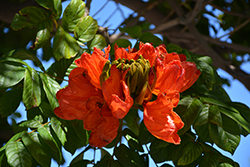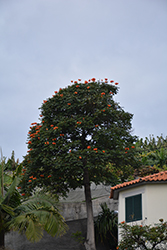Plant Library
Height: 50 feet
Spread: 50 feet
Sunlight:
![]()
![]()
Hardiness Zone: 10a
Other Names: Fountain Tree, Flame of the Forest, Nandi Flame
Description:
One of the most beautiful of all flowering trees, this African variety is stunning as a landscape accent, producing vivid blooms all year; very sensitive to cold and not tolerant of frost; invasive in some areas; must be well drained
Ornamental Features
African Tulip Tree features showy clusters of red cup-shaped flowers with orange streaks at the ends of the branches from late winter to late fall. It has attractive green evergreen foliage which emerges coppery-bronze in spring. The pointy pinnately compound leaves are highly ornamental and remain green throughout the winter. However, the fruit can be messy in the landscape and may require occasional clean-up. The smooth gray bark is extremely showy and adds significant winter interest.
Landscape Attributes
African Tulip Tree is a multi-stemmed evergreen tree with an upright spreading habit of growth. Its average texture blends into the landscape, but can be balanced by one or two finer or coarser trees or shrubs for an effective composition.
This is a high maintenance tree that will require regular care and upkeep, and is best pruned in late winter once the threat of extreme cold has passed. It is a good choice for attracting butterflies and hummingbirds to your yard. Gardeners should be aware of the following characteristic(s) that may warrant special consideration;
- Invasive
- Insects
- Disease
African Tulip Tree is recommended for the following landscape applications;
- Accent
- Shade
- Hedges/Screening
Planting & Growing
African Tulip Tree will grow to be about 50 feet tall at maturity, with a spread of 50 feet. It has a low canopy with a typical clearance of 4 feet from the ground, and should not be planted underneath power lines. It grows at a medium rate, and under ideal conditions can be expected to live for 60 years or more.
This tree does best in full sun to partial shade. It does best in average to evenly moist conditions, but will not tolerate standing water. It is not particular as to soil type or pH. It is somewhat tolerant of urban pollution. Consider applying a thick mulch around the root zone in winter to protect it in exposed locations or colder microclimates. This species is not originally from North America.



